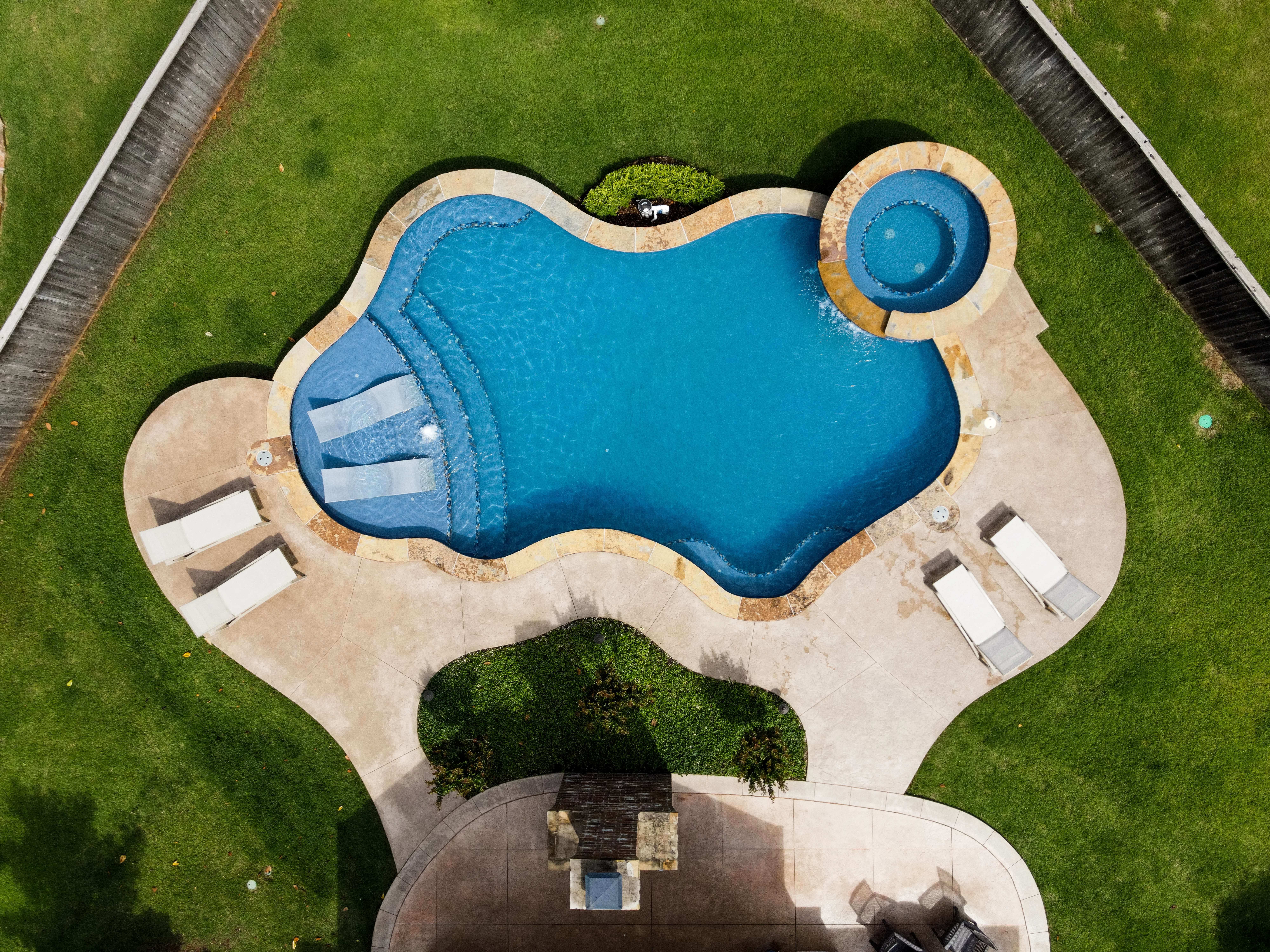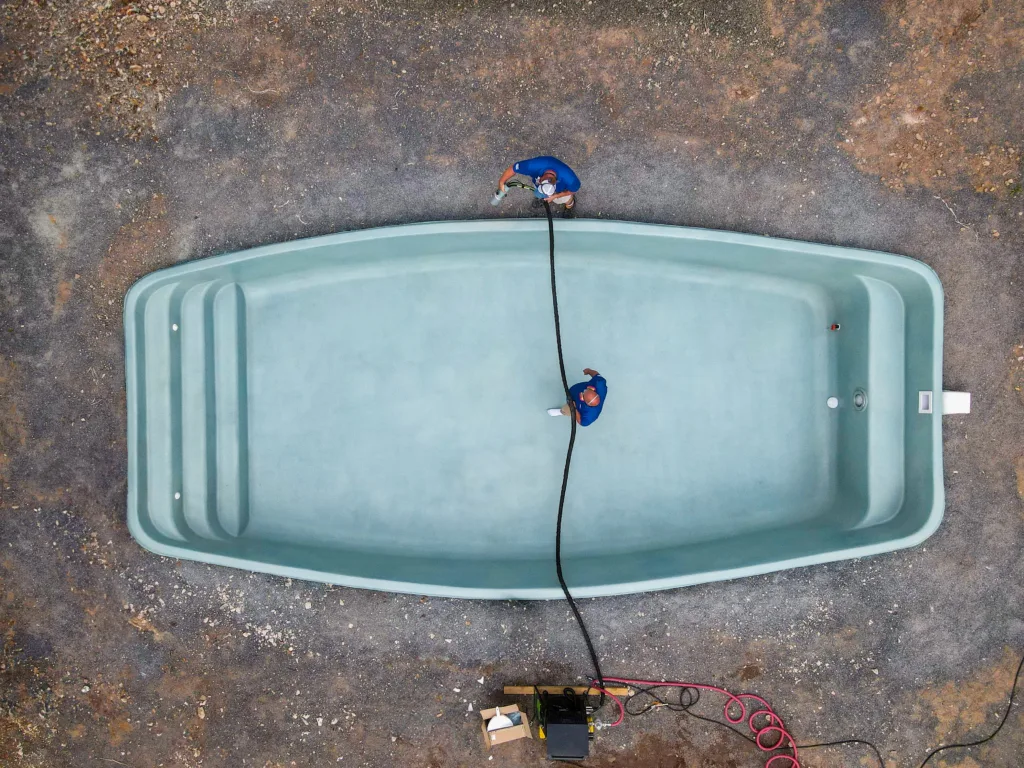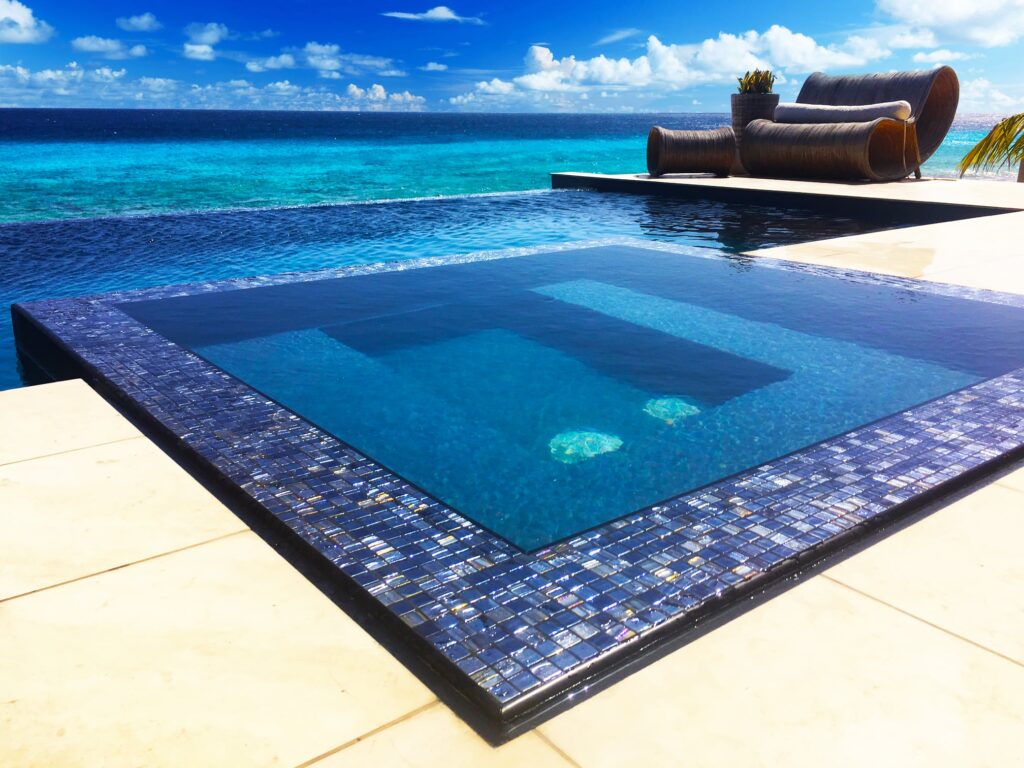What is the Best Type of Pool Resurfacing?

Choosing the right type of pool resurfacing can be a challenge. Many don’t realize how many options, like plaster, paint, and tiles, are available. This blog will guide you through selecting the best pool resurfacing materials based on durability, cost, and aesthetics.
Pool Resurfacing Options
Pool resurfacing offers various options to revamp your pool, including plaster, paint, fiberglass, concrete, aggregate, and tile. Each option has its unique benefits and methods of application.
Plaster
Plaster has been a top choice for pool resurfacing for many years. It’s known for its smooth finish and durability, making it a go-to option for homeowners. With plaster, you get a traditional white surface that brightens the pool’s appearance and reflects light beautifully underwater.
Although newer materials have emerged, plaster remains popular due to its cost-effectiveness and proven track record in the industry.
Paint
Epoxy paint can be an excellent option for pool resurfacing, with a lifespan of up to 10 years. It is a dependable and cost-effective choice compared to plastering, making it an attractive option for pool owners looking for durability at a reasonable price.
For those seeking more than just functionality, epoxy paint offers aesthetic appeal alongside its practical benefits, presenting a versatile solution for pool renovation that combines reliability with visual attractiveness.
Check out our friends at Optus Resin Technology’s revolutionary water-based epoxy coating for swimming pools.
Fiberglass
Fiberglass is a popular choice for pool resurfacing due to its durability and low maintenance. It is known for lasting up to 20 years, making it a cost-effective option in the long run.
Fiberglass also provides a smooth surface that inhibits algae growth, reducing the need for harsh chemicals in pool maintenance. Its non-porous nature prevents water absorption and chemical damage, adding to its longevity and resistance to staining.
Moreover, fiberglass resurfacing offers an array of color choices allowing customization based on individual preferences while ensuring high tensile strength and flexibility. Additionally, due to its non-abrasive nature, it provides a comfortable swimming experience whilst enhancing safety standards through slip-resistant coatings if desired by the user.
ecoFINISH’s polyFIBRO is a great option to add on to an existing fiberglass pool. This high-performance coating enhances the durability and aesthetic appeal of fiberglass surfaces. PolyFIBRO’s application creates a seamless, attractive finish that extends the life of your pool while offering superior resistance to UV rays, chemicals, and physical wear. It’s an ideal choice for those seeking to upgrade their fiberglass pool with a state-of-the-art coating solution.

Aggregate (Pebble)
Pebble is a popular choice for pool resurfacing, known for its durability and aesthetic appeal. It involves applying small, smooth pebbles to the pool surface, creating a natural and luxurious finish.
This option can last over 15 years with proper maintenance, making it a long-term investment.
When seeking more than just an ordinary resurfacing material, aggregate (pebble) becomes an attractive option that combines durability and sustainability.
When compared to other options like plaster or paint, pebble can be a superior choice in terms of longevity and low maintenance needs. Moreover, its textured surface provides additional safety by offering improved traction for swimmers while also adding an aesthetically pleasing touch to the pool area.
Tile
Tiles offer a durable and aesthetically pleasing option for pool resurfacing. They are known for their longevity and can provide an elegant finish to the pool surface. While they may come with a higher price tag, tiles are often chosen for their ability to withstand harsh weather conditions and maintain their appearance over time.
Additionally, unlike some other materials that can deteriorate over time, tiles typically require minimal maintenance and are resistant to discoloration or damage from chemical treatments.
This makes them an ideal choice for those seeking long-term value from their pool resurfacing investment. Epoxy grout is commonly used with tiles in pool resurfacing as it provides added strength and resilience against water absorption while ensuring overall structural integrity.
ecoFINISH
ecoFINISH coatings are revolutionizing the pool resurfacing industry with their innovative and durable solutions. These coatings, such as aquaBRIGHT and polyFIBRO, are designed to provide a smooth, vibrant finish that is resistant to fading, staining, and chipping.
ecoFINISH coatings offer several advantages. They’re highly resistant to chemicals, UV rays, and physical wear. They create a non-porous surface that inhibits algae growth and reduces the need for harsh chemicals, making maintenance easier and more cost-effective.
Available in a wide range of colors, ecoFINISH coatings can be customized to match any design preference and can be applied to various pool surfaces, including plaster, concrete, fiberglass, and even metal.

Factors to Consider When Choosing the Best Type of Pool Resurfacing
Consider durability, cost, and aesthetics when choosing the best pool resurfacing option. Evaluate the long-term maintenance and visual appeal alongside the financial investment.
Durability
Durability is a key factor when choosing a pool resurfacing material. Plaster, while cost-effective and popular, generally lasts around 7 to 10 years before needing resurfacing. Fiberglass is known for its impressive durability, lasting up to 20 years with proper maintenance.
Aggregate finishes can also be quite durable, lasting over 15 years. Tiles often exceeding 20 years with minimal maintenance, while epoxy paint provides a durable, albeit shorter-term solution, typically lasting up to 10 years. ecoFINISH coatings offer enhanced durability by providing superior resistance to UV rays, chemicals, and physical wear, extending the life of the pool surface significantly.
Cost
Cost is another important consideration. Plaster is generally the most affordable option, with a moderate cost and decent lifespan. Epoxy paint offers a cost-effective solution with a good balance of price and durability. Fiberglass resurfacing is more expensive initially but provides long-term savings due to its extended lifespan and low maintenance requirements.
Aggregate finishes, while slightly more costly than plaster, offer a unique aesthetic and durability that justify the investment. Tiles are typically the most expensive option, reflecting their longevity and low maintenance needs. ecoFINISH coatings, while premium in cost, provide exceptional value through their durability and reduced maintenance expenses over time.
Aesthetics
Aesthetics play a significant role in choosing pool resurfacing materials. Plaster offers a classic, smooth white finish that brightens the pool’s appearance. Epoxy paint comes in various colors, allowing for customization and a vibrant look. Fiberglass provides a sleek, smooth surface available in multiple colors, enhancing the pool’s visual appeal.
Aggregate pebble finishes create a natural, luxurious appearance, adding texture and color to the pool. Tiles offer a sophisticated, elegant finish, available in various patterns and colors to match any design preference. ecoFINISH coatings provide a modern, seamless look with a wide range of color options, ensuring a visually stunning pool surface.
Conclusion
Selecting the right resurfacing material for your pool involves considering factors like durability, maintenance, cost, and aesthetics. Each option has its strengths and can be the perfect choice depending on your specific needs and preferences. Whether you opt for the traditional appeal of plaster, the durability of fiberglass, the luxurious finish of pebble, or the innovative coatings from companies like ecoFINISH, ensuring your pool’s surface is in top condition will enhance your swimming experience for years to come.
FAQs
The best type of pool resurfacing depends on various factors like durability, smoothness, and color. Generally, the more expensive options are the best.
Yes, there are multiple types. The choice depends on your preference and budget.
Pool refinishing costs can vary based on the size of your swimming area, the chosen material for surfacing and the specific techniques used in the repair process.
Yes, you can resurface a pool yourself. While it’s demanding and requires careful preparation, with the right tools and effort, it’s achievable. However, some finishes, like pebble or ecoFINISH, require professional installation.
A pool can be resurfaced multiple times, depending on the type of pool material and its durability. Regular maintenance and proper care can help prolong the intervals between resurfacing.
